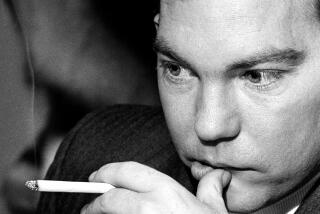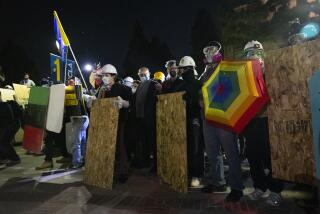‘Killing Fields’ was his story
One day during the rise of the Khmer Rouge regime in the mid-1970s, American journalist Sydney Schanberg asked his Cambodian assistant, Dith Pran, a gnawing question.
How would Dith respond to the American diplomat in Phnom Penh who had been publicly criticizing Cambodians for not rising up against the communist insurgents, who were killing innocent countrymen every day? Was it because, as the diplomat insinuated, Cambodians did not value human life as highly as Westerners did?
The question hung in the air for long minutes until Dith found the words to respond.
“It’s not true. You have seen for yourself the suffering,” he told Schanberg softly. “The only difference, maybe, is that with Cambodians the grief leaves the face quickly, but it goes inside and stays there for a long time.”
For slaughter on the scale inflicted by the Khmer Rouge -- an estimated 1.5 million died of starvation, executions, overwork and torture -- the grief could be immobilizing, but not for Dith. He saved Schanberg from death at rebel hands before facing it himself many times during the four years of the Khmer Rouge’s bloody reign. When Schanberg won the 1976 Pulitzer Prize for his Cambodia reporting at the New York Times, he shared the honor with Dith.
How the scrappy Cambodian managed to survive was incomprehensible even to Dith. Yet he prevailed and with Schanberg’s help began life anew in the United States as a staff photographer for the Times. Dith emerged as an eloquent spokesman for the victims of the Cambodian slaughter, a role he filled until his death from pancreatic cancer Sunday at a hospital in New Brunswick, N.J., Schanberg said. He was 65.
“A clear-eyed reporter who lived through horror and survived to tell his story in his own words, for 30 years Dith Pran . . . played a key role in bringing the crimes of Pol Pot’s Khmer Rouge regime to world attention, especially in the United States,” said Ben Kiernan, founding director of the Cambodian Genocide Program at Yale University.
Inspiration for film
Dith’s struggle to outlast the brutality and be reunited with his family and Schanberg inspired the 1984 Academy Award-winning movie “The Killing Fields.” Hailed as a hero, he was honored at the White House and was named a goodwill ambassador to the office of the United Nations High Commissioner for Refugees, but he never forgot the Cambodians, living and dead, he had left behind.
He established the Dith Pran Holocaust Awareness Project to educate students about the atrocities. He sought to preserve evidence of the slaughter and bring the perpetrators before an international tribunal as a member of the Cambodia Documentation Commission, a human rights group. And he compiled first-person accounts of the Khmer Rouge’s crimes against children in a 1998 book, “Children of Cambodia’s Killing Fields.”
“I am a Cambodian holocaust survivor,” he often declared, “and I have to be a messenger.”
One of six children in a middle-class family, he was born Sept. 27, 1942, in Siem Reap, a township near the Angkor temples in northwest Cambodia. He learned French in school and taught himself English.
After high school, he worked as an interpreter for the U.S. Military Assistance Group in Cambodia for five years, until Cambodia severed relations with the U.S. in 1965. As the Vietnam War spilled across the Cambodian border and the Khmer Rouge swept the countryside, he became a guide and translator for foreign journalists. That is how, in 1972, he met Schanberg, a Singapore-based correspondent for the Times, who quickly dominated coverage of the Cambodian civil war. The temperamental journalist and the bright, resourceful Cambodian became fast friends, and by mid-1973 Dith worked exclusively for Schanberg as an official New York Times stringer.
Though not trained as a journalist, Dith instinctively drove for the scoop using whatever means necessary. In one of the biggest stories he and Schanberg covered together, Dith bribed a patrol boat crew to take them to a Mekong River town that an American B-52 bomber had mistakenly targeted, leaving 400 injured or dead. He bribed another crew to speed them back to Phnom Penh so the correspondent could meet his deadline.
Schanberg later wrote that Dith witnessed so much senseless death that he “began to see in journalism a way to reveal his people’s plight.”
By 1975, the two men were as close as brothers. On April 17, the day the Khmer Rouge stormed the capital of Phnom Penh, Schanberg, Dith, their driver and two other foreign journalists were confronted by a band of heavily armed soldiers. Schanberg believed they would be killed on the spot, a fear bolstered by the raw terror on the face of the usually imperturbable Dith.
They were shoved inside the soldiers’ tank -- all except Dith. Schanberg could hear Dith’s frantic pleading in Khmer, the Cambodian language, and assumed he was bargaining for his own freedom. Only when the door of the tank opened and Dith tumbled in did Schanberg learn what Dith had been saying. The Cambodian driver told him that the Khmer Rouge had ordered Dith to leave, but Dith begged them to let him stay.
“He knew we had no chance without him,” Schanberg later wrote, “so he argued not to be separated from us, offering, in effect, to forfeit his own life on the chance that he might save ours.”
After “talking soothingly” with the soldiers for more than two hours, Schanberg said, Dith persuaded them to let everyone go.
They wound up at the French Embassy, where hundreds of Westerners were taking refuge. When night fell, Schanberg sneaked in Dith and spent the next few days hatching schemes to save him, including rigging a British passport. But French officials, anticipating a Khmer Rouge sweep of the embassy, told all the Cambodians that they had to leave. Schanberg said the memory of his faithful assistant being forced into the chaos outside haunted his sleep over the next years.
Life as nightmare
For Dith, life became an unremitting nightmare. The Khmer Rouge were hellbent on a radical restructuring of Cambodian life, abolishing religion, separating families, driving city dwellers to rural labor camps, closing hospitals and schools, and exterminating professionals, intellectuals and anyone with ties to Westerners or the U.S-backed government of President Lon Nol. The atrocities he witnessed, particularly the murders of children, plagued him long after he was free.
He survived by donning peasant clothes and passing himself off as a taxi driver. Banished to the countryside, he soon was working in rice fields for 14 to 18 hours a day. His feet became infected because only the Khmer Rouge were allowed to wear shoes. With food scarce, he ate bark, mice and insects and sucked blood from an ox for sustenance. One night he was so hungry he stole some rice but was caught. A dozen members of the commune committee pounded him with the bladed tools they used to cut bamboo, then sentenced him to death. A devout Buddhist, he prayed all night and in the morning was spared because of a Khmer Rouge cadre who liked him and convinced the others to show mercy.
In early 1979, when Vietnam invaded Cambodia and drove the Khmer Rouge from power, Dith felt safe enough to return to his village. Given his education and ties to foreigners, the villagers were astonished that he was still alive. His father had died of starvation, and three brothers and a sister had been executed. Only his mother, a sister and a few other relatives survived.
A ghastly discovery underscored how lucky he was. Two village women took him into the forest, where human bones were everywhere. Scattered among the trees and clogging the wells were the remains of as many as 5,000 Cambodians, Dith’s kin probably among them.
“The grass grew taller and greener where the bodies were buried,” Dith later said of the killing fields, which were found in nearly every village in the country.
Dith was appointed village mayor by the Vietnamese overseers but was forced to resign after they learned that he had worked for an American journalist. Fearful of recriminations, he fled, walking 100 miles to a refugee camp across the Thailand border.
Schanberg, who had been searching for his friend since their forced parting four years earlier, found him there days later. “I am reborn,” Dith sobbed when he saw Schanberg again. “This is my second life.”
His new life unfolded first in San Francisco, where his wife, Ser Moeun, and their four children had settled after fleeing Phnom Penh before its fall. Once the severely malnourished Dith recovered his health, they moved to New York, where the Times trained him to become a news photographer. He became known for his human-interest photos.
Going after Pol Pot
The years away from his family took a toll on his marriage, which ended in divorce. His survivors include his children, Titony Dith of Herndon, Va., Hemkarey Dith Tan of Silver Spring, Md., Titonath Dith and Titonel Dith, both of Lynwood, Wash.; a sister; and eight grandchildren.
In 1989 he returned to Cambodia with members of the Cambodian Documentation Commission, including Haing S. Ngor, the Cambodian doctor who portrayed Dith in “The Killing Fields.” Ngor won an Oscar for his wrenching performance, in part because he, like Dith, had lived through unimaginable horror.
He and Dith shared a common goal: to see Pol Pot stand trial for leading one of the worst slaughters of the 20th century. But Ngor died in 1996, shot to death by robbers on a Los Angeles street. Dith vowed to continue their fight to make the former dictator answer for his crimes.
Two years after Ngor’s death, Pol Pot died under house arrest in Cambodia within hours of an announcement that the Khmer Rouge was turning him over to an international tribunal. His death -- reportedly from heart failure but possibly from suicide -- thwarted Dith’s hope for justice and a measure of peace.
“There is no doctor who can heal me,” he told the Los Angeles Times some years ago. “But I know that a man like Pol Pot, he is even sicker than I am . . . because he believed in killing people. He believed in starving children.
“We both have the horror in our heads. In Cambodia, the killer and the victim have the same disease.”
--
More to Read
Sign up for Essential California
The most important California stories and recommendations in your inbox every morning.
You may occasionally receive promotional content from the Los Angeles Times.











